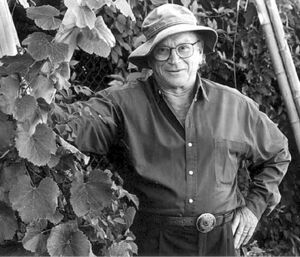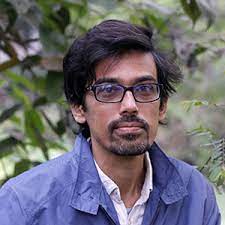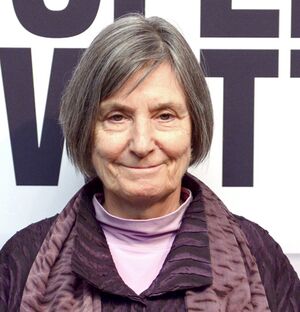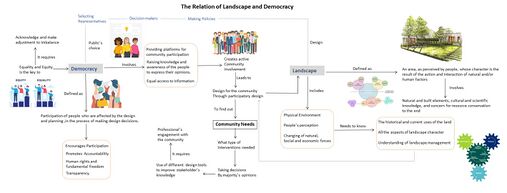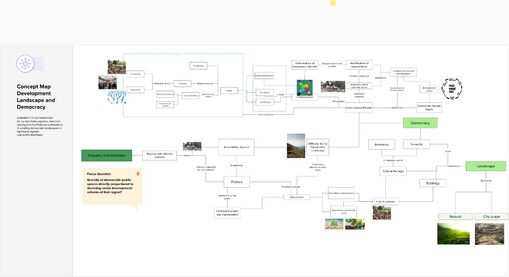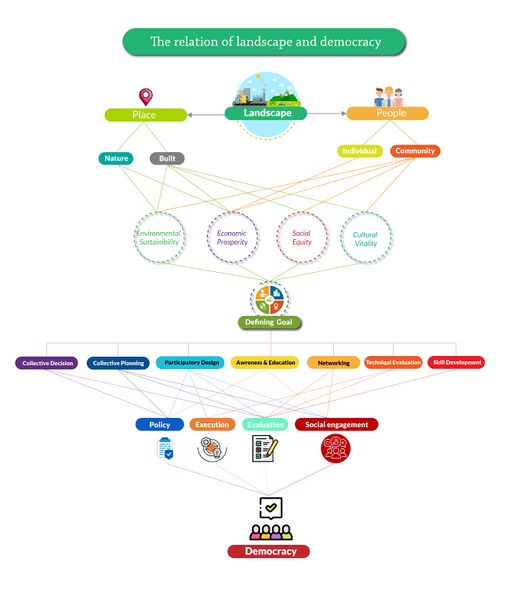Democratic Landscape Transformation 2023 - Team 8
>>> Back to working group overview
>>> Back to seminar reading list
>>> go to the Editing Help
Our team
- Malavika Mohan Das : Architect based in Kerala, India with experience and interest in sustainable and landscape architecture.
- Aynun Nur Sadia: An Architect based in Chattogram, Bangladesh. I started my professional career with some residential projects and later I got some opportunities to work on various projects. I am interested in Landscape Architecture as it can provide a range of scopes to think creatively and foster communities.
- Rafi Ahmad : An architect based in Dhaka, Bangladesh, and an aspiring landscape architect with a passion for sustainability and environmental protection. Strive to create designs that harmonise with nature, enhance biodiversity, and promote the well-being of communities.
Our Landscape Democracy Manifestoes
Links to the manifestoes we have presented on April 26
- Malavika's Manifesto : https://docs.google.com/presentation/d/1_w3rMWd9l-eaknS3fQEyKK7beVZlXCmG4RRy1jDVFPk/edit?usp=sharing
- Marinos Kokkinos's Manifesto : https://drive.google.com/file/d/1T0ham0kAKeXibzOTiQ9hPlqGQR0X7z2M/view
- Aynun Nur Sadia´s Manifesto : https://drive.google.com/file/d/1PyMCjdZWz2umbIFTAGIEW5jbynzcmAF2/view?usp=sharing
- Rafi Ahmad's Manifesto : https://drive.google.com/file/d/19t8_4wHzona5YQ8BnYdpt9X-poVKMYrU/view
Examples of Landscape Activism
In the session on May 10 we discussed examples of landscape activism.
- Malavika´s Design Activism: https://docs.google.com/presentation/d/1ps5L2LyO4ybwRIJqqA3eQLLPI9xgmGehQOCz6tHXkvk/edit?usp=sharing
- Rafi Ahmad´s Design Activism: https://drive.google.com/file/d/1-_RrIFPk2sGdm5UykiS6uEI8fcNQW0sT/view?usp=share_link
- Aynun Nur Sadia´s Design Activism: https://drive.google.com/file/d/1f8xrpahhw-C-yP234-ZkxOqgoQ8SH9RC/view?usp=sharing
The Role Play
In the session on May 17, we presented a small role play with our team. For the role play, the link of our chosen manifesto is given below:
https://drive.google.com/file/d/1PyMCjdZWz2umbIFTAGIEW5jbynzcmAF2/view?usp=sharing
We chose an activist to role play individually.
Aynun Nur Sadia
Activist: Karl Linn(1923-2005), United States
Karl Linn is an American Landscape Architect, Psychologist, Educator, and Community Activist. Best known for inspiring and guiding the creation of "Neighborhood Commons" on vacant lots in East Coast inner cities during the 1960s-1980s.
He employed a strategy called “Urban Barn raising" .Linn is considered as 'Father of American Participatory Architecture' by many academic colleagues and architectural and environmental experts of the National Endowment for the Arts. Linn believed in “Participatory Architecture”. He engaged neighborhood residents, volunteer professionals, students, youth teams, social activists, and community gardeners in envisioning, designing, and constructing instant, temporary, and permanent gathering spaces in neighborhoods, on college campuses, at sites of major conferences and events.
Link to the full presentation with the overview of Linn´s life, works, philosophy of works, challenges he faced and the role playing of how he would address the challenge of chosen manifesto is given below:
https://drive.google.com/file/d/1AXZ4cGHqLQUdTCVrcecbn7MaXD4kf-0i/view?usp=sharing
Reflection:
I was so inspired by his philosophy of works. It was so amazing to learn how he gathered people from different cultures, background and ensured their participations in envisioning, designing and constructing of a project. How he produced positive self identifications within community members and design students was quite interesting. His tactics to focus on work training programs and the establishment of "Process Institutions" made me so amazed. Focusing on local assets like using local materials, blending Art with the nature was on of his strategy of works .
i learned from his works how to share knowledges and work together. In my perspective it´s really important to engaged the community to share knowledge and utilizing it for designing the common spaces they share.
Rafi Ahmad
Activist: Khondaker Hasibul Kabir (1985-), Bangladesh
Khondaker Hasibul Kabir is a Bangladeshi landscape architect and sustainability advocate who works in rural and sustainable design with Bangladeshi development organisations such as BRAC and Grameen. He is the co-founder of Co.Creation.Architects, which works with human and non-human communities to co-create better-built and natural habitats. He is a core team member of the Platform of Community Action and Architecture (POCAA) which works in Bangladesh and Community Architects Network (CAN) which works in 19 Asian countries. He teaches landscape and architecture at BRAC University, Bangladesh. Co.Creation.Architects received the UIA 2030 Award and the Aga Khan Award for Architecture 2022 for their works.
A link to the full presentation with an overview of Kabir´s life, works, philosophy of works, challenges he faced, and role-playing of how he would address the challenge of his chosen manifesto is given below:
https://drive.google.com/file/d/1QmI9-QOSQnlbZgNOZMHTk5wkTgzndEsA/view?usp=share_link
Reflection:
His work strategy impressed me tremendously. It was fascinating to learn how he brought together people from all backgrounds and assured their participation in the conceptualization, planning, and construction of a project. His strategies to focus on job training programmes and the tool "Networking" astounded me. His efforts taught me how to share information and collaborate. In my opinion, it is vital to involve the community in the exchange of information and its application in the creation of cooperative environments.
Malavika Mohan Das
Activist: Anne Whiston Spirn (1947-), United States
Anne Whiston Spirn is an award-winning author, landscape architect, photographer, teacher, and scholar. Her work is devoted to promoting life-sustaining communities: places that are functional, sustainable, meaningful, artful, and just, places that help people feel and understand the relationship between the natural and built worlds. Spirn is Cecil and Ida Green Distinguished Professor of Landscape Architecture and Planning in the Department of Urban Studies and Planning of the MIT School of Architecture and Planning. She is the 2001 winner of the International Cosmos Prize.
A link to the full presentation with an overview of Anne´s life works, philosophy of works, challenges she faced, and role-playing of how she would address the challenge of her chosen manifesto is given below:
https://drive.google.com/file/d/1QmI9-QOSQnlbZgNOZMHTk5wk
Reflection:
Spirn's contributions to landscape activism extend beyond her design practice. She has written extensively on topics such as urban ecology, river restoration, and the relationship between nature and culture.
Anne Whiston Spirn's work and ideas continue to inspire and shape the field of landscape architecture, advocating for sustainable design, community engagement, and the creation of landscapes that reflect the values and aspirations of the people who inhabit them.
Her portfolio: https://www.annewhistonspirn.com/work/portfolio/
Readings, concepts and definitions
- Start: April 5, 2023
- Due: July 5, 2023
Working in your group, express your personal understanding of the relation of landscape and democracy in the form of a concept map with linking words or any other diagrammatic representation. Please make your maps very visual and not just verbal. Think critically about why one map differs from another
About concept mapping
Before starting the exercise you can read this article by Joseph D. Novak & Alberto J. Cañas about Theory Underlying Concept Maps and How to Construct and Use Them. This paper gives a good explanation of how concept maps are conceived and developed.
You can use any tool you like for producing your concept map. However, since the result needs to be submitted digitally we recommend the following open source software for producing your maps:
- Cmap Tools >>> you can also work with your group on the Cmap cloud doing a shared map
- VUE - The Visual Understanding Environment
Our concept map
Reflection
- The similarities in our team is involvement of the communities and the difference we felt is the interactions of the communities on multiple levels. We have identified that the connecting factors in all three scenarios is the interaction between the community and the decision makers. It´s also visible that the cultural context and the involvement of the change makers varies across. Volunteers from respective fields such as activists, ecologists, political leaders and architects are bringing actions calling for change.
- The seminar helped in identifying different methods used across the world to bring positive change and also impactful even the slightest but carefully thought intervention could be beneficial.
- Even though we were aware about the need for change in the current climate crisis, there was confusion about how we could contribute. But this program, helped in opening up the opportunities to contribute in different ways.
